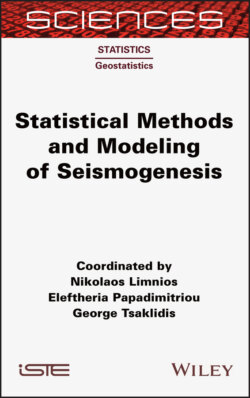Читать книгу Statistical Methods and Modeling of Seismogenesis - Eleftheria Papadimitriou - Страница 31
2.3.2. Frequency-magnitude distribution of the simulated catalog (2015)
ОглавлениеIn the application of the simulator, the rectangular source area representing the CGFS was discretized in 6,288 cells of 0.5 × 0.5 km. We chose for the synthetic catalogs a minimum magnitude of 4.0, which is produced approximately by the rupture of six cells. According to the “Ellsworth B” relation between magnitude and fault area (WGCEP 2003), the magnitude of earthquakes rupturing the entire CGFS (the area of which is 1,572 km2) would be 7.4. The duration of all the synthetic catalogs was 100,000 years. In order to explore the effect of the two free parameters, S-R and A-R separately, we carried out a series of eight simulations, each time using different combinations of these parameters. This effect is illustrated in Figure 2.5 by the magnitude-frequency density distribution of the earthquakes contained in the respective synthetic catalogs. Figures 2.5(a) and 2.5(b) show that the first free parameter, S-R, does have influence on the total number of earthquakes contained in the catalogs. The difference clearly comes from the substantial contribution given to the moment released by the high magnitude range, maintaining the same constraint for the moment rate released by the entire fault system.
Figure 2.5. Frequency-magnitude distribution of the earthquakes in the synthetic catalogs obtained from the simulation algorithm with different combinations of two free parameters described in the text. In panels a, b and c, labels (1) and (2) refer to the values of parameters S-R and A-R, respectively. The total seismic moment released by the events in all the synthetic catalogs is the same. The bottom data refer to the earthquakes observed in the area starting in 1911 (based on Console et al. 2015). For a color version of this figure, see www.iste.co.uk/limnios/statistical.zip
Figure 2.5(c), where the three plots refer to three different values of the second free parameter A-R, does not show visible differences in the distribution below magnitude 6.0, but a clear difference of the shape above this threshold. This is explained by the fact that parameter A-R has discourages the size of a rupture to expand beyond a length that exceeds A-R times the width of the fault segment. All the plots shown in Figure 2.5 show a clear deviation of the magnitude distribution obtained by the simulation algorithm from a plain linear Gutenberg–Richter distribution. In some cases, the magnitude distributions show a sharp “bump” around a value of magnitude that could be defined as “characteristic” behavior. All three panels of Figure 2.5 also show the magnitude density distribution of the real earthquakes observed in the Corinth fault system and reported in the seismic catalog since 1911. On the basis of a visual comparison, it seems possible to recognize the set of free parameters (0.10, 1.0) as the one that exhibits the best match between the real and simulated catalogs (Figure 2.5(b)), taking into account the large difference in the different scale of the total number of events. This combination of parameters produces a nearly flat magnitude distribution (i.e. a b-value equal to 0) in the magnitude range 5.5 < M < 6.5 that reminds us of the unsegmented option of the WGCEP (2008). In the following, we shall show results of a simulation lasting 100,000 years, obtained by running our algorithm with the selected free parameters S-R and A-R, respectively, equal to 0.1 and 1.0.
